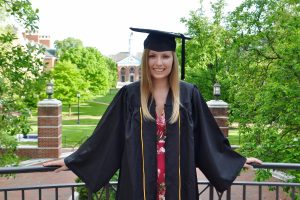
For Katarina Mayer (BS ‘20), this year has been a whirlwind of academic achievements. In May, Mayer earned her Bachelor’s in Biomedical Engineering with a second major in Computer Science. The Toronto native’s research interests include cloud computing and networking. In 2021, Mayer will earn her Master’s in Computer Science.
To learn more about Mayer and her next steps, check out this brief Q&A.
What are your research plans for the upcoming academic year?
My research will focus on investigating the effects of microbursts in asymmetric datacenter networks. Microbursts are one of the major areas of focus of Computer Science Professor Soudeh Ghorbani’s lab. The overarching goal of this research is to improve datacenter efficiency as datacenters are a vital part of what keeps much of the Internet running today.
When did you first discover the STEM field?
Both of my parents studied engineering and exposed me to the STEM field early on. Towards the end of high school, I worked in a multi-disciplinary lab at the University of Toronto which focused on building assistive technologies for rehabilitation medicine. During this hands-on experience, I gained more formal exposure to the disciplines of engineering, computer science and medicine.
Why did you choose to attend Hopkins?
Hopkins uniquely builds research and design into the curriculum of its undergraduate engineering programs. As early as freshman year, Biomedical Engineering students work in teams to design solutions addressing real-world clinical needs. Likewise, Computer Science undergraduates apply cutting-edge research to interdisciplinary projects alongside their graduate peers.
What was your favorite undergraduate course and why?
Cloud Computing was my favorite course at Hopkins. The course, which heavily emphasized critical thinking, focused on analyzing open research problems in cloud computing. The main component of the course was a project where students recreated and expanded upon the results of published research.
For the project, I explored the topic of Jellyfish networks. These asymmetric network designs offer many benefits over those currently in practice; however, they pose problems in traffic load balancing and congestion control. During the project, I built a network simulation and implemented routing algorithms to recreate the results of a research paper. I also experimented with a new traffic routing heuristic adapted from a study in robotic motion planning. Working on this project gave me a deeper appreciation for the complexity of this domain and ultimately encouraged me to pursue further research in cloud computing.
What are your summer plans?
I am working as a Quantitative Trading Software Development Intern at Marshall Wace North America L.P., an asset management firm in New York City.
Established in memoriam of the department’s inaugural chair and founding director of the Information Security Institute, Professor Gerald M. Masson, the fellowship was created in the summer of 2018 for students in the Combined Bachelor’s/Master’s Program. The program enables undergraduates to apply for and begin taking courses towards a master’s degree before completing their bachelor’s degree. The fellowship provides a 25% tuition waiver for the semester in which an awardee is conducting the graduate research, provided they are enrolled full time.
To learn more about the Combined Bachelor’s/Master’s Program, click here. To learn more about the Gerald M. Masson Fellowship, click here.